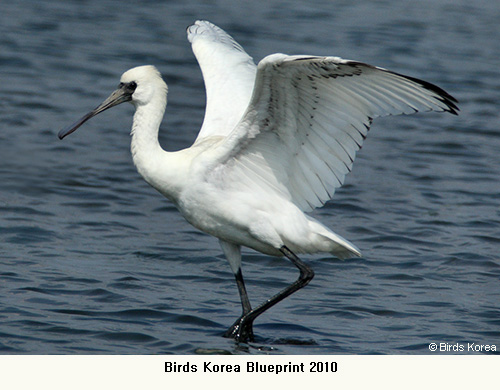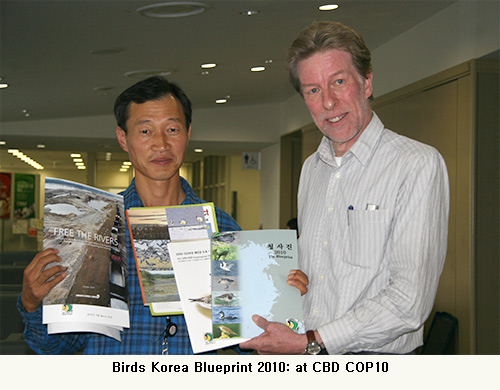The Birds Korea Blueprint 2010 (Birds Korea 2010) is now available in hard copy and online. The 160-page long report provides essential background information on key habitats, species and sites in a large section of the South Korean part of the Yellow Sea, or Yellow Sea Blueprint Region (YSBR). Funding and capacity allowing, Birds Korea will produce a follow-up document in 2012. As proposed, “The Blueprint 2012” will build on background information, contain analysis of some population trends and describe the status of the YSBR’s Important Bird Areas and Ramsar sites.
The publication of “The Blueprint 2010” comes at a critical time – towards the end of the International Year on Biodiversity, and as decision-makers commit themselves once more to reducing rates of biodiversity loss, e.g. in line with commitments made to the United Nation’s Millennium Development Goals. Clearly, action is urgently needed in this region. Already participants at the Convention on Biological Diversity COP10 have learned that the status of waterbirds around the world is worst in Asia, where “62% of waterbird populations are decreasing or even extinct”. Moreover, according to Professor Nick Davidson, the Deputy Secretary General of the Ramsar Convention in the same press release, “It is not surprising that the rate of decline of the long distant migrant sandpipers, snipes and curlews (shorebirds) has accelerated most rapidly. Now, 70% of their populations are decreasing. Halting destruction of their migratory staging areas is vital” (Wetlands International 2010).
Executive summary
The Birds Korea Blueprint aims to support ongoing conservation initiatives as part of the Republic of Korea’s (ROK) efforts to reduce the rate of biodiversity loss (by 2010), in line with commitments to the Millennium Development Goals. It is a collection of articles and recommendations based on the understanding that biodiversity underpins the functioning of the ecosystems on which people also depend for life and livelihood. The Blueprint’s focus is the conservation of avian biodiversity of the ROK part of the Yellow Sea or “Yellow Sea Blueprint Region” (YSBR), and contains essential information on key sites, species and conservation initiatives divided into three main habitats (intertidal wetland, open sea areas, and islands).
The YSBR is at the heart of the East Asian - Australasian Flyway, and 34 out of c.340 annually-occurring species are globally threatened. At the same time, the YSBR is a region under huge development pressure. Reclamation is the major driver of avian biodiversity decline and has reduced the national area of intertidal wetland by more than 70% to only c.106,000ha (1060km2), less than half the estimate of remaining “coastal wetland” in the official Fourth National Report to the Convention on Biological Diversity (2009). The health of remaining intertidal wetland is also threatened by pollution, estuary dams and infrastructure development along rivers, including the Four Rivers project. The majority of shorebird species and species dependent on intertidal wetlands are therefore in decline or are globally threatened. The 40,100ha Saemangeum reclamation, one of many ongoing projects, has already resulted in the loss of livelihood of >20,000 local people and a measurable decline in shorebirds at both the site and the Flyway level. This includes >20% of the world population of Great Knot Calidris tenuirostris (requiring its reassessment as globally Vulnerable on the IUCN Red List). Additional reclamation and mega-projects, e.g. tidal-power plants in Incheon, will cause further massive habitat loss and further declines.
There is less information on seabirds and birds on islands of the YSBR. However, the marine environment of the Yellow Sea is increasingly “stressed” and seabirds at sea are likely threatened by oil and other pollution, in addition to unsustainable fisheries. In addition, some seabird colonies, including of the Swinhoe’s Storm Petrel Oceanodroma monorhis, are threatened by invasive alien species. Many migrant bird species on islands, like the island-nesting Styan’s Grasshopper Warbler Locustella pleskei, also appear to be in decline.
The Blueprint therefore recommends that data needs to be shared, science needs to underlie policy, and improved collaboration is required to achieve a reduction in the rate of biodiversity loss.
The 2010 online version of The Blueprint will, as intended, be updated regularly, and made available for participants to the 2012 IUCN World Congress (Republic of Korea).
The Blueprint 2010 is available online and for download.
Birds Korea, October 24th 2010
References
- Birds Korea. 2010. The Birds Korea Blueprint 2010 for the conservation of the avian biodiversity of the South Korean part of the Yellow Sea. Published by Birds Korea, October 2010.
- Wetlands International. 2010. State of the World’s Waterbirds: in trouble in Asia, recovering in ‘the West’ http://www.wetlands.org/NewsandEvents/NewsPressreleases/tabid/60/articleType/
ArticleView/articleId/2445/Default.aspx

Funding for the publication of The Blueprint (2010) has been provided by the Rufford Small Grants Foundation, timed for release at the Tenth Conference of the Parties of the Convention on Biological Diversity (October 2010).








